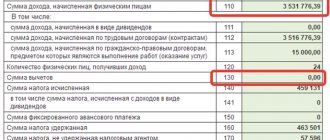Who should issue an invoice?
When selling goods, services, works, etc. primary documentation is required.
So, according to paragraph 3 of Art. 168 of the Tax Code of the Russian Federation, invoices are issued under certain conditions:
| Conditions for issuing an invoice | Invoice deadline |
| No later than five calendar days, counting from the day:
|
Why is an invoice needed?
In accordance with Art. 169 of the Tax Code of the Russian Federation, an invoice is a document that serves as the basis for the buyer to accept the goods (work, services), property rights presented by the seller (including the commission agent, agent who sells goods (work, services), property rights on their own behalf) tax amounts to deduction.
In other words, VAT can be deducted only on the basis of an invoice. Neither an invoice, nor a delivery note, nor a cash receipt, nor other documents serve as the basis for issuing a tax deduction.
The form for providing an invoice can be:
- in paper form;
- in electronic form (by mutual agreement of the parties to the transaction and if these parties have compatible technical means and capabilities for receiving and processing these invoices).
In the event of an error in invoices, which does not prevent the tax authorities from conducting a tax audit, identifying:
- seller;
- buyer of goods (works, services);
- property rights;
- name of goods (works, services);
- price;
- tax rate;
- the amount of tax presented to the buyer is not a basis for refusing to accept tax amounts for deduction.
The invoice issued for the sale of goods (work, services), transfer of property rights must indicate:
- serial number and date of invoice;
- name, address and identification numbers of the taxpayer (tax agent) and the buyer;
- name and address of the shipper and consignee;
- number of the payment and settlement document in case of receiving advance or other payments for upcoming deliveries of goods (performance of work, provision of services);
- name of the goods supplied (shipped) (description of work performed, services provided) and unit of measurement (if it is possible to indicate it);
- quantity (volume) of goods (works, services) supplied (shipped) according to the invoice based on the units of measurement accepted for it (if it is possible to indicate them);
- name of currency;
- identifier of the government contract, agreement (agreement) (if any);
- price (tariff) per unit of measurement (if it is possible to indicate it) under the agreement (contract) excluding tax, and in the case of applying state regulated prices (tariffs) that include tax, taking into account the amount of tax;
- the cost of goods (work, services), property rights for the entire quantity of goods supplied (shipped) according to the invoice (work performed, services rendered), transferred property rights without tax;
- the amount of excise duty on excisable goods;
- tax rate;
- the amount of tax imposed on the buyer of goods (works, services), property rights, determined based on the applicable tax rates;
- the cost of the total quantity of goods supplied (shipped) according to the invoice (work performed, services rendered), transferred property rights, taking into account the amount of tax;
- country of origin of the goods;
- Number of customs declaration;
- code of the type of product in accordance with the unified Commodity Nomenclature for Foreign Economic Activity of the Eurasian Economic Union.
The invoice is signed by the head and chief accountant of the organization or other persons authorized to do so by an order (other administrative document) for the organization or a power of attorney on behalf of the organization.
When issuing an invoice by an individual entrepreneur, the invoice is signed by the individual entrepreneur or another person authorized by a power of attorney on behalf of the individual entrepreneur, indicating the details of the state registration certificate of this individual entrepreneur.
An invoice drawn up in electronic form is signed with an enhanced qualified electronic signature of the head of the organization or other persons authorized to do so by an order (other administrative document) for the organization or a power of attorney on behalf of the organization or individual entrepreneur.
According to paragraph 5 of Art. 168 of the Tax Code of the Russian Federation, when selling goods (work, services) by taxpayers exempt from fulfilling their duties as a taxpayer, invoices are drawn up without allocating the corresponding tax amounts. In this case, the corresponding inscription or stamp “Without tax (VAT)” is made on these documents .
When issuing an invoice, the seller makes the following accounting entry:
| Debit | Credit | Explanation |
| 90.3 | 68/VAT | VAT calculation |
The buyer paying VAT, based on the received invoice, makes the following accounting entries:
| Debit | Credit | Explanation |
| 19 | 60.1 | Input VAT |
| 68/VAT | 19 | Tax deduction statement |
Comparative characteristics
Enterprises and individual entrepreneurs who are VAT payers use an invoice. The need for this document lies not in the promptness of payments, but in proving the fact that the fees have been paid in full, which in turn provides the opportunity to withhold VAT from the payer.
Distinctive features
An invoice and an invoice are two different documents. They are created for the same purpose, but have different meanings. The differences between the documents are as follows:
- An invoice is required for the buyer's side to pay the amount specified in the contract. To do this, it contains all the necessary details.
- The invoice reflects transactions in tax accounting. Its necessity lies in obtaining the opportunity to deduct VAT.
Presence of basic similarities
The main correspondence between an invoice and an invoice is shown in the table below:
| Check | Invoice |
| Method and format in which information is presented | |
| Data that the document contains | |
| All information is provided in table form | |
| The table consists of 5 columns (as short a summary of information as possible) | The table consists of 11 columns |
Difference between invoice and delivery note
Consequently, the invoice is easier to prepare, as it contains less information.
Many agree that both documents have an identical appearance in relation to each other. However, the only difference they have is the presence of a special seal on the delivery note. In all other respects, these are two identical documents.
The important thing is that their main difference is in purpose:
- An invoice is a document for accounting reporting on VAT accounting and its deduction.
- The delivery note is proof of the transfer of ownership of a particular product.
Another reason why they should not be confused: these documents cannot replace each other or perform two functions at once. Thus, a tax invoice does not make it possible to obtain a tax deduction, and an invoice does not provide a fact confirming ownership of a particular product.
Correlation with invoice
The word invoice has two meanings. Let's define each of them:
- An invoice (as a commercial invoice) is a document drawn up by the seller to the buyer containing information about the provision of services, the cost and quantity of goods, information about the sender and recipient. This document is also significantly similar to an invoice.
- An invoice (like an invoice) is drawn up by the seller to the buyer, thereby documenting the amount of the goods and its delivery.
An invoice (like a commercial invoice) has little in common with an invoice. It contains expanded requirements for the buyer regarding the payment specified in the document.
When issued, an invoice (like an invoice) contains information identical to the invoice. Accordingly, it can be noted that they have practically no differences.
Differences between a deed and an invoice
Often the organization providing services provides two documents at once:
- An invoice is a document of strict accounting reporting.
- The certificate of completion of work does not have a unified form and is drawn up at the discretion of the organization.
They are partly similar. This applies exclusively to the details contained therein and information about the services provided and the price.
The types of invoices are presented in this video.
about the author
Grigory Znayko Journalist, entrepreneur. I run my own business and know first-hand the problems and difficulties that individual entrepreneurs and LLCs face.
Nuances when issuing an invoice
According to Art. 169 of the Tax Code of the Russian Federation, invoices are of the following types:
| Invoice type | When is it issued? | Normative act |
| Invoice | when selling goods (works, services), transferring property rights | clause 5 art. 169 Tax Code of the Russian Federation |
| Adjustment invoice | when the cost of shipped goods (work performed, services rendered), transferred property rights changes downward, including in the event of a decrease in price (tariff) and (or) a decrease in the quantity (volume) of shipped goods (work performed, services rendered) transferred property rights, | clause 1 art. 169 Tax Code of the Russian Federation |
| Invoice for prepayment (advance payment) | upon receipt of payment, partial payment for upcoming deliveries of goods (performance of work, provision of services), transfer of property rights | clause 5.1 art. 169 Tax Code of the Russian Federation |
Reasonability and care that the taxpayer failed to exercise and flawed invoices
Blaming the taxpayer for not showing the necessary amount of reasonableness and conscientiousness in relations with his counterparties is a kind of cash cow for the tax authorities in the modern Russian Federation. Although, for legal completeness, they still need to provide some kind of documentary justification for this.
Quite often this is confirmed by the fact that, in the opinion of the tax authorities, invoices do not comply with the requirements of Art. 169 of the Tax Code of the Russian Federation, therefore the taxpayer loses the right to a tax deduction.
Most often, courts proceed from the fact that insufficient prudence in choosing a counterparty, if he has not fulfilled his tax obligations, can lead to adverse consequences in tax legal relations. Such consequences may include denial of the right to a benefit or a tax deduction.
From the definition of the Constitutional Court of the Russian Federation dated January 24, 2008 N 33-О-О, it follows that when considering the issue of the legality of applying tax deductions, arbitration courts must examine the entire set of circumstances that are important for the correct resolution of the case. This is the fact that the buyer has paid for the goods, the presence of documents other than invoices confirming the payment of tax as part of the price of the goods and other parameters.
In Resolution dated 02/07/2012 No. A55-4035/2011, the FAS Volga District noted that a taxpayer cannot be considered in good faith if, when choosing a counterparty, he did not show the necessary measures of caution and diligence. The negative consequences were the result of his imprudence in choosing a counterparty and inappropriate attitude towards documenting relations with him. Therefore, he lost the right to tax deductions.
Why is an invoice required?
The invoice does not have a strictly regulated form, but it is of great importance in the relationship between the seller and the buyer.
When issuing an invoice, you must provide the following information:
- seller details;
- buyer details;
- subject of the transaction (name, quantity, cost);
- details of the agreement on the basis of which the invoice for payment was issued;
- serial number;
- date of document generation.
In addition to the specified information, the invoice may contain the following information:
- the exchange rate on the basis of which the invoice was issued;
- due date;
- conditions under which the paid goods will be shipped to the buyer.
Thus, an invoice for payment is a document, guided by which the buyer pays for goods, work, or services. The transfer of goods is most often carried out after payment of the invoice.
What is the difference between an invoice and an invoice?
Please note that an invoice and an invoice are completely different documents that serve different purposes:
| An invoice for payment | Invoice |
| Is it necessary to prepare a document? | |
| No need to register | Mandatory if we are talking about VAT-related transactions |
| Why is the document drawn up? | |
| To provide the buyer with payment details and payment amounts | To make a tax deduction for VAT |
| Document form | |
| There is no strict regulation of the document form | Approved by Decree of the Government of the Russian Federation of December 26, 2011 No. 1137 “On the forms and rules for filling out (maintaining) documents used in calculations of value added tax” |
| Types of documents | |
| The seller has only one invoice form for payment |
An advance invoice and a regular invoice are issued on the same forms. |
| Document meaning | |
| Does not imply reporting, matters when making payments | Is the basis for conducting transactions with VAT |
An invoice and an invoice have some common characteristics:
| An invoice for payment | Invoice |
| Who draws up the document? | |
| Salesman | Salesman |
| What details does the document contain? | |
| Buyer and seller | Buyer and seller |
| How is VAT reflected? | |
| VAT is included in the cost of goods, work or services | VAT is included in the cost of goods, work or services |
| Document submission form | |
|
|
Briefly
- An invoice and an invoice have significant differences.
- An invoice is an offer to pay for a product, service, or product. An invoice can either reflect existing contractual obligations or serve as an offer. It is not a mandatory document.
- An invoice is the basis for recognizing a VAT deduction as legal. All invoice details, deadlines and rules for its execution are strictly regulated. The document is mandatory for use by organizations and individual entrepreneurs conducting VAT calculations.
- A universal transfer document (UDD) combines the features of a primary document and an invoice. Can be used by all organizations of any form of ownership, as well as entrepreneurs. Treated by tax authorities similarly to an invoice when used accordingly by the taxpayer. Its application is not mandatory and is prescribed in the accounting policies.





